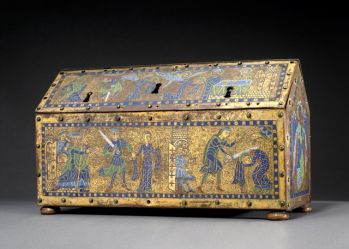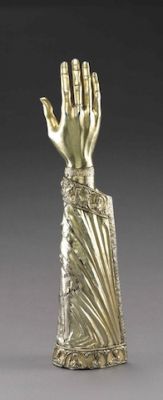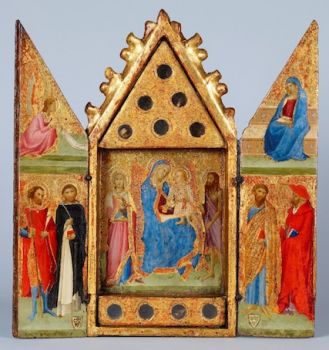Treasures of Heaven: Saints, Relics and Devotion in Medieval Europe, British Museum | reviews, news & interviews
Treasures of Heaven: Saints, Relics and Devotion in Medieval Europe, British Museum
Treasures of Heaven: Saints, Relics and Devotion in Medieval Europe, British Museum
The breath, foreskin and umbilical chord of Christ preserved as Holy relics
At the end of my road is a shrine dedicated to a young man murdered there more than a year ago. For the first few months lighted candles, plastic flowers, cards and poems penned by friends and relatives were left on a doorstep; now, though, a blue plaque commemorating his short life has appeared on the wall above a constantly burning flame. Over the years the messages have also changed from outpourings of sorrow to words of adulation; the lad, who by all accounts was a drug-dealing ne’er-do-well, has been elevated to the realm of sainthood by grieving parents determined to keep the flame of remembrance burning.
The desire to keep memories of the dead alive is as old as human society; they provide solace and confirm one’s sense of identity. In most early religions, ancestral graves provided a focal point for communal celebrations and the performance of sacred rites involving ritual objects such as bones, idols, medicinal herbs and other offerings.
The ancient Romans held annual ceremonies in the catacombs, leaving glass medallions at the tombs of their loved ones, and adorned sacred places with votive offerings requesting a cure, say, for blindness or help in conceiving a child. Exploring the importance of relics in Christianity over the centuries, Treasures of Heaven points out how the early Christians continued these traditions, but since the new religion was illegal, they had to be extremely circumspect. In AD 64, the Emperor Nero murdered hundreds of Christians in Rome, yet the fledgling faith continued to spread, and some 50 years later the Emperor Hadrian felt it necessary to discourage pilgrimage to Jerusalem by levelling the supposed site of Jesus’s tomb and building a temple to Aphrodite over it.
T he Emperor Constantine legalised Christianity in AD 313 and moved the capital of the Roman Empire to Constantinople. A few years later, he sent his mother Helena to Jerusalem to demolish the temple of Aphrodite and construct a basilica in its place. The Church of the Holy Sepulchre not only incorporated Christ’s tomb but also the rock of Calvary on which the crucifixion took place, so it was bound to become a major focus for Christian pilgrimage.
he Emperor Constantine legalised Christianity in AD 313 and moved the capital of the Roman Empire to Constantinople. A few years later, he sent his mother Helena to Jerusalem to demolish the temple of Aphrodite and construct a basilica in its place. The Church of the Holy Sepulchre not only incorporated Christ’s tomb but also the rock of Calvary on which the crucifixion took place, so it was bound to become a major focus for Christian pilgrimage.
Meanwhile in his new capital, Constantine was building the Hagia Sophia as the official home of the new religion, but because of its distance from the Holy Land, it lacked the prestige of the Church of the Holy Sepulchre. Help was at hand, though; during the excavations, Helena supposedly discovered the remains of the True Cross on which Christ had been crucified and began dispatching fragments back to her son.
After that the dissemination of relics throughout Christendom began in earnest and Constantine was able to confirm his authority and that of his church by amassing the largest collection of all.
At first believers were reluctant to violate the bodies of saints and apostles and rationed themselves to removing peripheral items such as hair, teeth, nails and garments. But the corpses of martyrs who had met hideous deaths were already mangled, so removing a severed head or fragments of broken bone became excusable. Soon everything from blood and tears to bits of bone were treated as sacred commodities to be labelled, wrapped in silk and shipped off to a customer who would commission a reliquary to house the precious item.
 The best craftsmen were employed to make gold or silver caskets (Reliquary Chasse with St Valerie from Limoges, pictured above right), often studded with precious gems, which took the form of houses or temples, crucifixes or altarpieces, rings or pendants. During the 12th century, “speaking reliquaries” in the shape of a body part such as a hand, foot or head became popular. Arm reliquaries, such as the eloquent reliquary of an apostle from 1190 (pictured left), which may or may not have contained fragments of an arm bone, were used to dramatic effect during the mass and in religious processions.
The best craftsmen were employed to make gold or silver caskets (Reliquary Chasse with St Valerie from Limoges, pictured above right), often studded with precious gems, which took the form of houses or temples, crucifixes or altarpieces, rings or pendants. During the 12th century, “speaking reliquaries” in the shape of a body part such as a hand, foot or head became popular. Arm reliquaries, such as the eloquent reliquary of an apostle from 1190 (pictured left), which may or may not have contained fragments of an arm bone, were used to dramatic effect during the mass and in religious processions.
St Ursula was a fourth-century British believer who supposedly embarked on a pilgrimage with 11,000 virgins, all of whom were massacred in Cologne where their bones are to be found in the Basilica of St Ursula. Made from painted wood, busts portraying the young women often contain skulls of the deceased.
By the 14th century relics were also being housed in small panel paintings designed for private prayer. The exquisite altarpiece by Sienese painter Lippo Vanni (pictured below) would have had relics embedded in the recesses above and below the image of the Virgin.
Reliquaries often contained many items. A 13th-century mosaic of The Man of Sorrows, the dead Christ revealing his wounds, is framed by a wooden surround containing over 200 relics whose combined power attracted thousands of pilgrims to Santa Croce in Rome during the 15th and 16th centuries. Relics were a big draw. When the Sudarium (the cloth with which Veronica wiped the face of Christ as he carried the cross to Golgotha) was brought to Rome in 1450, the crush to see it was so great that the balustrades of the Ponte Sant’ Angelo gave way and 200 people fell into the River Tiber and drowned.
 Not surprisingly the market became overheated and the substances on offer more and more outlandish – from the Virgin’s milk to Christ’s breath, foreskin and umbilical cord, which was supposedly saved by two midwives in attendance at his cowshed birth.
Not surprisingly the market became overheated and the substances on offer more and more outlandish – from the Virgin’s milk to Christ’s breath, foreskin and umbilical cord, which was supposedly saved by two midwives in attendance at his cowshed birth.
In the 16th century protesters such as Martin Luther felt the time had come to cleanse the temple and by this stage in the exhibition I also felt I had had enough of this superstitious nonsense. "How do we know we are venerating the ring and comb of the Virgin Mary rather than the baubles of a harlot?” asked John Calvin in his Treatise on Relics in 1543. And during the Reformation that followed thousands of reliquaries were destroyed by iconoclasts or were transformed into everyday items such as salt cellars.
Lest we imagine that belief in the power of relics was eradicated through these reforms, though, it is worth remembering that when the relics of St Thérèse of Lisieux were displayed for four days at Westminster Cathedral in 2009, 100,000 people queued to see them. The shrine at the end of my road may not contain any relics, but it is still a potent symbol of the urgent desire to keep hold of the dead, whether they be saints or sinners.
- Treasures of Heaven: Saints, Relics and Devotion in Medieval Europe at the British Museum until 9 October
The future of Arts Journalism
You can stop theartsdesk.com closing!
We urgently need financing to survive. Our fundraising drive has thus far raised £49,000 but we need to reach £100,000 or we will be forced to close. Please contribute here: https://gofund.me/c3f6033d
And if you can forward this information to anyone who might assist, we’d be grateful.

Subscribe to theartsdesk.com
Thank you for continuing to read our work on theartsdesk.com. For unlimited access to every article in its entirety, including our archive of more than 15,000 pieces, we're asking for £5 per month or £40 per year. We feel it's a very good deal, and hope you do too.
To take a subscription now simply click here.
And if you're looking for that extra gift for a friend or family member, why not treat them to a theartsdesk.com gift subscription?
more Visual arts
 'We are bowled over!' Thank you for your messages of love and support
Much-appreciated words of commendation from readers and the cultural community
'We are bowled over!' Thank you for your messages of love and support
Much-appreciated words of commendation from readers and the cultural community
 Abstract Erotic, Courtauld Gallery review - sculpture that is sensuous, funny and subversive
Testing the boundaries of good taste, and winning
Abstract Erotic, Courtauld Gallery review - sculpture that is sensuous, funny and subversive
Testing the boundaries of good taste, and winning
 Edward Burra, Tate Britain review - watercolour made mainstream
Social satire with a nasty bite
Edward Burra, Tate Britain review - watercolour made mainstream
Social satire with a nasty bite
 Ithell Colquhoun, Tate Britain review - revelations of a weird and wonderful world
Emanations from the unconscious
Ithell Colquhoun, Tate Britain review - revelations of a weird and wonderful world
Emanations from the unconscious
 Rachel Jones: Gated Canyons, Dulwich Picture Gallery review - teeth with a real bite
Mouths have never looked so good
Rachel Jones: Gated Canyons, Dulwich Picture Gallery review - teeth with a real bite
Mouths have never looked so good
 Yoshitomo Nara, Hayward Gallery review - sickeningly cute kids
How to make millions out of kitsch
Yoshitomo Nara, Hayward Gallery review - sickeningly cute kids
How to make millions out of kitsch
 Hamad Butt: Apprehensions, Whitechapel Gallery review - cool, calm and potentially lethal
The YBA who didn’t have time to become a household name
Hamad Butt: Apprehensions, Whitechapel Gallery review - cool, calm and potentially lethal
The YBA who didn’t have time to become a household name
 Bogancloch review - every frame a work of art
Living off grid might be the meaning of happiness
Bogancloch review - every frame a work of art
Living off grid might be the meaning of happiness
 Do Ho Suh: Walk the House, Tate Modern review - memories are made of this
Home sweet home preserved as exquisite replicas
Do Ho Suh: Walk the House, Tate Modern review - memories are made of this
Home sweet home preserved as exquisite replicas
 Ed Atkins, Tate Britain review - hiding behind computer generated doppelgängers
Emotions too raw to explore
Ed Atkins, Tate Britain review - hiding behind computer generated doppelgängers
Emotions too raw to explore
 Echoes: Stone Circles, Community and Heritage, Stonehenge Visitor Centre review - young photographers explore ancient resonances
The ancient monument opens its first exhibition of new photography
Echoes: Stone Circles, Community and Heritage, Stonehenge Visitor Centre review - young photographers explore ancient resonances
The ancient monument opens its first exhibition of new photography

Add comment